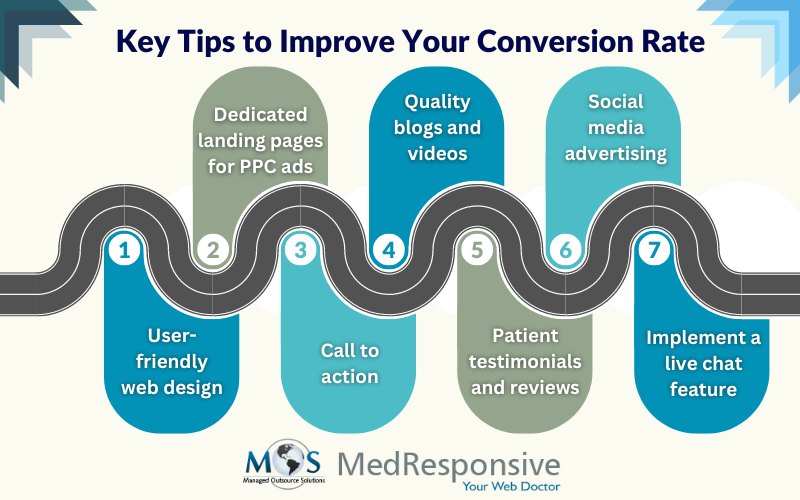In today’s competitive healthcare scenario, optimizing your medical website for conversions is crucial. Optimizing your website can increase its visibility and reach. The effectiveness of your website can be greatly impacted by important components like design, content strategy, and trust signals. Medical SEO services can help you implement best practices to build patient trust and increase your site’s conversion rates. While macro-conversions refer to considering treatment from your practice or requesting a consultation, micro-conversions include signing up for email lists, or signing up for an account.
Strategies to Optimize Conversion Rates
There are 100 billion searches for healthcare on Google alone per year, according to WebFX. Every day, 70,000 queries pertaining to health are made per minute. When looking for physicians, dentists, hospitals, or other healthcare professionals, 75% of patients search online. The average conversion rate in the healthcare industry is 3.2% overall. You are doing well, though, if your conversion rate is higher than 5%. From 5% to 10% is considered good and over 10%, exceptionally good.
- Attractive and user-friendly web design: Designing a medical website is not the same as creating a page for an e-Commerce site or any other business.A responsive, easy-to-navigate website is more likely to attract potential patients to your website. Your website’s performance can affect your conversion rates.
Never make your site visually complex, instead simplify your healthcare website design to keep your visitors focused on the content that matters. Page load speed is also a concern, as waiting for content to load becomes frustrating for users and may provoke them to leave the site or application altogether. Poor-loading websites can lead to poor search engine rankings, increased bounce rates, lower overall site traffic, and negative user experiences. The bounce rate is the percentage of users who leave a website after viewing only one page.
- Dedicated landing pages for pay-per-click ads: Make sure that your landing page as well as homepage provides details about the major treatments or servicesthat potential patients would like to know about. Create mobile-friendly landing pages for your PPC ads, as with well-designed ads you have the opportunity to reach new audiences. Consider creating different landing pages for each treatment you provide, along with strong and concise headers and sub-headers. Include only short forms in those landing pages, as potential patients may find lengthy and complicated forms quite frustrating.
- Add Call To Action: Along with focusing on page content, make sure you optimize Calls to Action in an appealing format. Find the right place in the website to add the CTA button such as’Contact Us’ or ‘Schedule Your Appointment’ to get more clicks.Highlighting this button at the end of each page prompts visitors to take the desired action.Also include your practice’s phone number, email ID, address and location in the footer, clearly and prominently.
- Quality content – blogs and videos: Publishing high quality content on your website in diverse formats such as infographics, videos, FAQs, blog posts and web pages can provide relevant and useful information to visitors. Video content is a powerful way to convey your message and bring more patients through the door. Educational videos are far more engaging than static text content. In your web page content, make sure to provide other key details such as the number of years you have been in the field, surgeries or treatments performed as well as patient’s success rate. Consider including the picture of the physician in relevant pages.
- Patient testimonials and reviews: Posting your current patients’ testimonials and their reviews can build trust among potential patients visiting your site. Adding testimonials on as many pages as possible can increase your conversion rates. It can also establish your expertise in the specialty. Also consider posting high quality video testimonials in your website, with the patient’s consent.
Provide the option for patients to add their reviews about your practice. More reviews equal to a higher conversion rate. If potential patients understand that others are satisfied with your service, chances are higher for them to schedule a consultation with you. You can create comment sections on your blog, which makes it clear that readers’ feedback is welcome and you encourage that.
- Social Media Advertising: The Unbounce conversion analysis states that for medical practices, traffic from social media channels had a higher median conversion rate than traffic from sponsored search. This suggests that your practice may see a rise in conversions as a result of sponsored social media advertising. Try out some social media advertising and evaluate the cost per conversion and conversion rate in comparison to other media. Remember that targeting and creativity are essential in social media marketing. Make sure to use video in your social media advertisements. Focus on strategies that target your best potential patients, including website retargeting and lookalike targeting based on your visitors to your site.
- Implement a live chat feature: Live support or Live help allows patients to make an appointment request even after office hours.Visitors can share their concerns and ask questions to the patient care representatives at the other endjust by clicking on the chat box.
Advantages of Conversion Rate Optimization for Healthcare Websites
There are various advantages to investing in conversion rate optimization for your clinic website:
- Increased Appointment Bookings: By making your website more conversion-friendly, you can increase the number of appointments that are scheduled, which can boost your clinic’s income.
- Increased Return on Investment: You can increase the return on your marketing investment by turning more website visits into consumers.
- Better User Experience: A smoothly functioning website offers a user-friendly experience that improves client satisfaction and your practice’s status.
- Competitive Advantage: By differentiating yourself from your rivals with a website that converts well, you can draw in more patients and obtain a competitive edge
By emphasizing trust signals, providing thorough but easily accessible information, and captivating multimedia resources, you provide a user-friendly environment that inspires confidence in prospective patients. Making navigation simpler and periodically reviewing your tactics is crucial to stay relevant. These initiatives advance meaningful conversions and enhance patient engagement. Medical SEO services are available to help you implement the right strategies to enhance your conversion rates.





